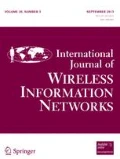Abstract
This work presents an admission control mechanism for multi-hop wireless mesh networks based on the IEEE 802.11 standard and the OLSR routing protocol. This mechanism, called CAC-OLSR, aims at ensuring that traffic flows with quality of service (QoS) requirements, especially voice and video, are only admitted in the mesh network if it has available resources in order to provide flow requirements. In addition, QoS requirements of previously admitted traffic flows cannot be violated. The proposal was evaluated with NS-2 and Evalvid simulations.


















Similar content being viewed by others
References
IEEE P802.11-2007 IEEE Standard for Information Technology Telecommunications and Information Exchange between Systems—Local and Metropolitan Area Networks—Specific Requirements, Part 11—Wireless Medium Access Control (MAC) and Physical Layer (PHY) Specifications, 2007.
IEEE P802.11e-2005 IEEE Standard for Local and Metropolitan Area Networks, Part 11—Amendment 8: Medium Access Control (MAC) Quality of Service Enhancements, 2005.
A. F. Conceição, J. Li, and D. A. Florêncio, Voice transmission over IEEE 802.11 networks: main issues and restrictions, in WebMedia ‘06 Proceedings of the 12th Brazilian Symposium on Multimedia and the web, Natal-RN, Brazil, 2006.
S. L. Su and Y. W. Su, Single phase admission control for QoS-routing protocol in ad hoc networks, Ad Hoc Networks, Vol. 9, pp. 1359–1369, 2011.
T. Clausen, and P. Jacquet, Optimized link state routing protocol (OLSR), RFC 3626, 2006.
M. E. M. Campista, P. M. Esposito, I. M. Moraes, L. H. M. K. Costa, O. C. M. B. Duarte, D. Passos, C. V. N. Albuquerque, D. C. Muchaluat-Saade and M. G. Rubinstein, Routing metrics and protocols for wireless mesh networks, IEEE Network, Vol. 22, pp. 6–12, 2008.
S. Sing, S. S. Sran, and T. Chand, Performance comparision of AODV, OLSR and OFLSR in wireless mesh networks, in National Conference of Challenges & Opportunities in Information Technology (COIT 2008), 2008.
E. P. S. Mineiro, and D. C. Muchaluat-Saade, Admission control for QoS provision in wireless mesh networks, in IEEE Symposium on Computers and Communications (ISCC), July 2012.
Evalvid—A video quality evaluation tool-set home page, http://www.tkn.tu-berlin.de/research/evalvid. Accessed Aug 2011.
K. Fall, and K. Varadhan, The network simulator—NS-2, http://www.isi.edu/nsnam/ns/. Accessed Aug 2011.
Y. Yang and R. Kravets, Contention-aware admission control protocol for ad hoc networks, IEEE Transactions on Mobile Computing, Vol. 4, pp. 363–377, 2005.
I. Chakeres and E. Belding-Royer, Perceptive admission control for wireless network quality of service, Ad Hoc Networks, Vol. 5, pp. 1129–1148, 2007.
A. Lindgren and E. Belding-Royer, Multi-path admission control for mobile ad hoc networks, ACM SIGMOBILE Mobile Computing and Communications Review, Vol. 8, pp. 68–71, 2004.
G.-S. Ahn, A. T. Campbell, A. Veres and L.-H. Sun, Supporting service differentiation for real-time e best-effort traffic in stateless wireless ad hoc networks, IEEE Transactions on Mobile Computing, Vol. 1, No. 3, pp. 192–207, 2002.
C. R. Cerveira, and L. H. M. K. Costa, A time-based admission control mechanism for IEEE 802.11 ad hoc networks, in 8th Mobile Wireless Communications Network, Santiago, Chile, 2006.
C. Perkins, and E. Belding-Royer, Ad hoc on-demand distance vector (AODV) routing, RFC 3561, 2003.
D. Nguyen, P. Minet, Interference-aware QoS OLSR for mobile ad hoc network routing, in Sixth International Conference on Software Engineering, Artificial Intelligence, Networking and Parallel/Distributed Computing and First ACIS International Workshop on Self-Assembling Wireless Networks (SNPD/SAWN’05), 2005.
H. Badis, and K. A. Agha, CEQMM: A complete and efficient quality of service model for MANETs, in International Symposium on Performance Evaluation of Wireless Ad Hoc, Sensor, and Ubiquitous Networks, 2006.
H. Badis, K. A. Agha, and A. Munaretto, Quality of service for ad hoc optimized link state routing protocol (QOLSR), in IETF-61 Meeting: Internet Engineering Task Force, draft-badis-manet-qolsr-00.txt, Washington, DC, November 2004.
G.-S. Ahn, A. T. Campbell, A. Veres, and L.-H. Sun, SWAN—Stateless Wireless Ad hoc Networks, http://comet.columbia.edu/swan/. Accessed Aug 2011.
F. J. Ros, OLSR protocol for the NS2 network simulator, University of MurciaMurcia, 2009.
S. Wiethölter, M. Emmelmann, C. Hoene and A. Wolisz, TKN EDCA Model for NS-2, Telecommunication Networks Group, Technische UniversitätBerlin, 2006.
Author information
Authors and Affiliations
Corresponding author
Rights and permissions
About this article
Cite this article
da Silva Mineiro, E.P., Muchaluat-Saade, D.C. CAC-OLSR: Extending OLSR to Provide Admission Control in Wireless Mesh Networks. Int J Wireless Inf Networks 21, 223–237 (2014). https://doi.org/10.1007/s10776-014-0242-z
Received:
Accepted:
Published:
Issue Date:
DOI: https://doi.org/10.1007/s10776-014-0242-z




